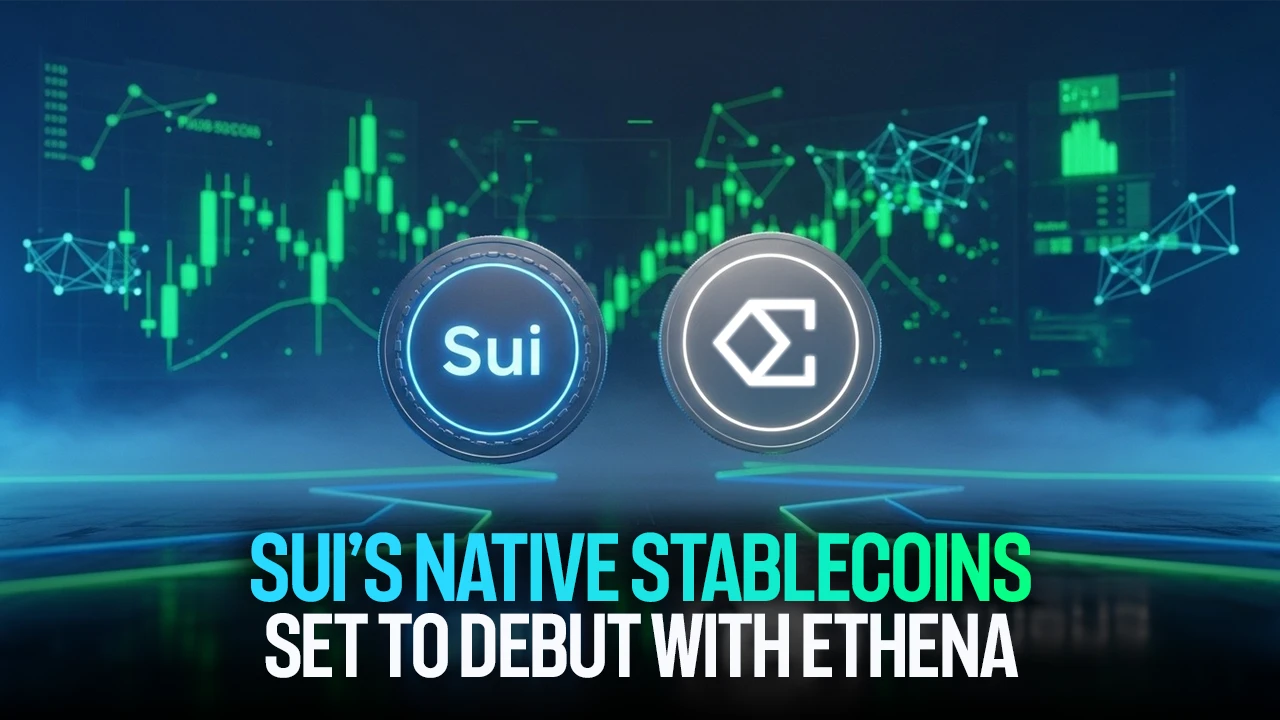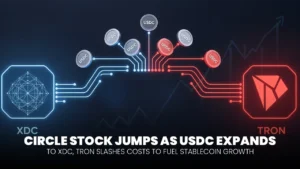Sui Brings Native Stablecoins to L1 Network, Partners with Ethena to Scale On-Chain Dollar

Sui is moving to introduce two native stablecoins to its layer-1 network, positioning the chain to capture a larger share of crypto’s dollar demand and to anchor liquidity across its DeFi stack. The plan introduces suiUSDe, an income-generating synthetic dollar powered by Ethena’s infrastructure, and USDi, a token backed by BlackRock’s tokenized money market fund, BUIDL.
- The Dual-Track Dollar Plan
- Market Reaction And Why It Matters
- Native Stablecoin Partners in Celebration Mode
- How do these Stablecoins Differ from the Rest?
- The Scale Context
- DPoS, Throughput, And Where Liquidity Tends To Settle
- Market Lens: What Investors Should Watch Next
- Sui Stablecoins Verified Figures and Milestones
- Conclusion
- Frequently Asked Questions About Sui’s First Native Stablecoins with Ethena
- How are these native stablecoins different?
- When will the stablecoins launch?
- Why is this significant for the DeFi ecosystem?
- How does this fit into the broader stablecoin landscape?
- Where does Delegated Proof of Stake come in?
- Are there risks investors should track?
- Glossary of Key Terms
The effort is a three-way collaboration among SUI Group, the Sui Foundation, and Ethena, marking a rare model where a publicly listed digital-asset treasury company helps originate stablecoin infrastructure for a base chain.
The sponsors expect both assets to go live before the end of 2025, with a stated goal of recycling net reserve income back into SUI purchases on the open market, thereby creating a flywheel for liquidity and on-chain activity. The announcement follows a period during which Sui posted high stablecoin transfer volumes, seeking to differentiate itself as a high-throughput settlement layer.
ALSO READ: Ark Invest’s $10M Push Into Securitize Signals Wall Street’s Big Shift to Tokenization
That timing matters. Stablecoins are the dominant use case in crypto, and flows tend to consolidate on chains that can handle payment-like throughput with low finality times.
Governance models also shape adoption. Delegated Proof of Stake (DPoS), used by several high-throughput ecosystems, has demonstrated how voter-elected validator sets can support scalability and fast confirmation, a factor that investors now consider as they evaluate where stablecoin activity will concentrate.
The Dual-Track Dollar Plan
Under the plan, suiUSDe will operate as a Sui-native version of Ethena’s USDe, using digital-asset reserves with short derivatives to maintain dollar exposure. The second asset, USDi, will be backed one-for-one by shares in BlackRock’s BUIDL fund, issued through a tokenization specialist, Securitize. The launch is described by the partners as the first collaboration of its kind among a public digital-asset treasury firm, a foundation, and a stablecoin provider.
Sui’s foundation framed the move as a way to add a stable, yield-bearing base asset directly into its DeFi core while routing net income to periodic purchases. That mechanic, if executed as outlined, would create a structural bid for SUI tied to the adoption of stablecoins on the chain. The partners also emphasize that Sui is the first non-EVM network to host a native income-generating stablecoin at this scale.
ALSO READ: Cardano Throws Governance, Cross-Chain Swaps Into the Ring Ahead of ETF Deadline
Bringing to Sui the first digital dollar of its kind in suiUSDe represents a major step forward and a new pillar of Sui DeFi infrastructure. Adeniyi Abiodun, Co-Founder and CPO, Mysten Labs.
Market Reaction And Why It Matters
Initial market response was constructive. Sui outperformed a broader crypto uptick after the news hit, with coverage highlighting a roughly 5 percent move and positioning the tokens as catalysts for liquidity depth. In a market where stablecoin velocity drives fee revenue and trading volume, anchoring native dollars can be a decisive differentiator for base-layer traction.
Introducing suiUSDe and USDi: two native dollar assets for the $30b+ @SuiNetwork built on our Stablecoin-as-a-Service stack.
These products will power DeFi and payments on Sui, while embedding Ethena directly within one of the fastest growing networks on earth.
Both suiUSDe &… pic.twitter.com/I4ptM6lcRw
— Ethena Labs (@ethena_labs) October 1, 2025
This also advances a strategic question: which settlement layers can turn stablecoin flows into durable network effects? In recent months, Ethena’s USDe has grown into a double-digit-billion-dollar asset, and Sui has reported strong stablecoin transfer volumes. If the two native stablecoins land as planned, they could nudge more payments and DeFi activity toward Sui, particularly for market makers that want native routing with minimal bridging friction.
Native Stablecoin Partners in Celebration Mode
Ethena pitched the collaboration as a way to embed its stablecoin-as-a-service stack into one of the crypto industry’s faster-growing networks. SUI Group emphasized its objective to build a Sui-centric liquidity hub, even using the phrase “SUI Bank” to describe a long-term vision for on-chain funding and treasury flows. The Sui Foundation spotlighted performance metrics and DeFi composability as the reason to bring an income-generating stable asset on-chain.
Two details stand out. First, the structure seeks to align incentives by directing net income from the stablecoin reserves back into Sui, a direct demand source that could strengthen market depth. Second, USDi’s backing via a tokenized BlackRock fund suggests a blend of traditional finance (TradFi) yield engines with crypto-native distribution, a model that could attract institutional workflows that require transparent collateral.
ALSO READ: Circle Deploys USDC and CCTP V2 on XDC Network to Simplify Cross-Border Payments
How do these Stablecoins Differ from the Rest?
The two-coin approach splits product, risk, and audience:
- suiUSDe: an income-generating synthetic dollar designed for DeFi strategies, collateralized with digital assets and short futures in a manner similar to USDe’s delta-hedged construction. This is aimed at users seeking a yield-bearing dollar inside composable apps.
- USDi: a fully backed token tied to shares of BlackRock’s BUIDL fund via Securitize. This may appeal to institutions that prefer a money-market-style exposure with on-chain transferability.
The mix covers active DeFi use cases and more conservative cash-management needs, a useful pairing for market makers, on-chain lenders, and treasury desks that want different risk-return profiles without leaving the network.
Group Partners with Ethena and the Sui Foundation to Launch the First Native Stablecoins https://t.co/QrIp22N23I pic.twitter.com/8OkG0TRx09
— Sui Group Holdings (SUIG) (@officialSUIG) October 1, 2025
The Scale Context
Ethena’s footprint offers a demand base. USDe has grown rapidly this year, and the project reports a multibillion-dollar supply with integrations across major trading venues. The team behind the crypto project, for its part, points to peak monthly stablecoin transfer volume in the hundreds of billions, arguing that the network can process payment-like flows at scale. If those figures continue to trend, native dollars could tighten the loop between on-chain settlement and off-chain cash management.
DPoS, Throughput, And Where Liquidity Tends To Settle
Delegated Proof of Stake continues to shape how many networks manage validator sets and confirmation speed. In DPoS, token holders elect delegates, an approach characterized by high throughput and rapid finality. As capital allocators benchmark settlement layers for stablecoin distribution, several DPoS chains have used this governance model to compete on performance and user experience. That context matters as Sui, a high-performance PoS chain, attempts to gain market share in execution, tooling, and composability.
In other words, governance choices influence user confidence and integration speed. DPoS has demonstrated how delegate elections can support predictable performance, which in turn lowers operational risk for payment-like flows. Sui’s strategy focuses on achieving similar end outcomes, faster settlement, and deep liquidity, despite its technical design differing under the hood.
Market Lens: What Investors Should Watch Next
The stablecoin initiative intersects with larger themes. First, tokenized cash products are transitioning from pilots to scaled issuance, often through strategic partners. Second, networks are competing to internalize stablecoin velocity because it drives fee revenue, lending depth, and volumes in spot and derivatives markets. Third, governance and validator design, whether DPoS or other PoS variants, must keep pace with throughput demands to attract fintech rails and market makers.
Execution risk remains. Synthetic dollars depend on robust hedging and transparent reporting. Tokenized fund-backed coins need clean issuance and custody links. The partners say they will bring both products to mainnet before year-end 2025, giving markets a clear timeline to judge delivery. The price action on announcement day indicated that attention was already present.
Sui Stablecoins Verified Figures and Milestones
| Metric | Value | Source |
| USDe ecosystem TVL (cited in release) | ~$14.8B | Business Wire press release, Oct 1, 2025 |
| Stablecoin transfer volume, Aug 2025 | $229B (monthly peak) | The Foundation blog, Oct 1, 2025 |
| Planned go-live window for suiUSDe and USDi | Before the end of 2025 | Business Wire press release, Oct 1, 2025 |
| USDi collateral | Shares of BlackRock BUIDL tokenized MMF via Securitize | CoinDesk coverage, Oct 1–2, 2025 |
| suiUSDe design | Synthetic dollar, delta-hedged model similar to USDe | CoinDesk coverage, Oct 1–2, 2025 |
| Initial price reaction post-news | ~+5% | CoinDesk Markets, Oct 2, 2025 |
Conclusion
The plan to introduce a synthetic dollar and a tokenized-fund-backed coin, both native to the chain, is a bid to lock in the stablecoin flows that drive on-chain finance. The mechanics are clear on paper: net income routed to SUI buys, a TradFi-backed cash token for conservative treasuries, and an income-generating instrument for DeFi.
The credibility of the partners, including a publicly listed treasury company and the team behind one of the year’s fastest-growing digital currencies, lends weight to the initiative. Delivery will determine impact, but early market reaction suggests investors see the potential. As governance models like Delegated Proof of Stake (DPoS) continue to make performance and validator accountability legible to users, the competition for stablecoin settlement is set to intensify, and Sui wants a front-row seat.
Frequently Asked Questions About Sui’s First Native Stablecoins with Ethena
How are these native stablecoins different?
suiUSDe is an income-generating synthetic dollar powered by Ethena’s architecture. USDi is backed one-for-one by BlackRock’s BUIDL fund via Securitize. The first targets DeFi yield and composability. The second targets cash management use with tokenized fund backing.
When will the stablecoins launch?
The partners say both assets are expected to go live before the end of 2025, with rollout sequencing to be confirmed closer to mainnet readiness.
Why is this significant for the DeFi ecosystem?
Native stablecoins can deepen liquidity, tighten on-chain settlement loops, and reduce reliance on bridges. The Foundation also plans to direct net income from reserves toward open-market purchases, aligning ecosystem incentives.
How does this fit into the broader stablecoin landscape?
Tokenized cash and synthetic dollars are converging. Ethena’s growth shows demand for yield-bearing dollars, while tokenized funds connect TradFi yield to crypto rails. Sui’s two-coin approach addresses both profiles on one chain.
Where does Delegated Proof of Stake come in?
DPoS is a governance model where token holders elect delegates to validate blocks. Its emphasis on speed and efficiency helps explain why high-throughput networks attract stablecoin activity. While Sui’s design differs, the market logic that rewards fast finality and predictable performance applies.
Are there risks investors should track?
Synthetic dollars require robust hedging and disclosures. Tokenized fund-backed coins rely on issuance and custody pipelines. Delivery against the stated 2025 timeline will be a key progress check.
Glossary of Key Terms
- Stablecoin: A cryptoasset designed to track a reference value, often the U.S. dollar.
- Synthetic Dollar: A stable asset maintained via derivatives and collateral rather than direct bank deposits.
- Tokenized Fund: A traditional fund represented on-chain as a transferable token.
- BUIDL: BlackRock’s tokenized money market fund used as collateral for on-chain tokens.
- USDe: Ethena’s synthetic dollar that uses delta-hedging to maintain dollar exposure.
- suiUSDe: Native, income-generating dollar built with Ethena’s stack.
- USDi: Sui-native stablecoin backed by shares of BUIDL.
- DPoS: Delegated Proof of Stake, a model where token holders elect block producers.
- Composability: The ability of on-chain applications to interoperate, stacking features and liquidity.
- Tokenization: Converting real-world or traditional financial assets into blockchain-based tokens.




